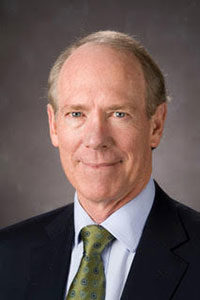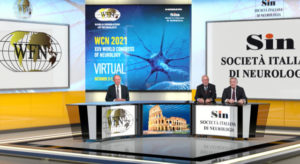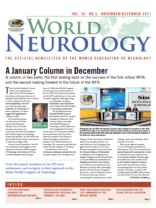
William Carroll, MD
A column of two parts: the first looking back on the success of the first virtual WCN, and the second looking forward to the future of the WFN.
This is my last President’s Column before a new administration takes over the WFN in January. I have drawn on the Janus theme as it is popularly believed January was so derived to be the ending of the old year and the beginning of the new year. Other interpretations emphasize the relationship of Janus to gateways. Yet others suggest the beginning and ending of conflict.
No matter how January was selected to be the first month of the Gregorian calendar, there is no doubt that Janus was Roman and it was Rome that was to have held the XXV World Congress of Neurology. Despite the pandemic, the XXV WCN was thematically Roman thanks to the Society of Italian Neurologists (SIN).
From the outset, members of the SIN were enthusiastic and energetic in their approach to the Rome World Congress of Neurology. Like everyone, SIN was extremely disappointed by having to move to a fully virtual World Congress of Neurology. The combined efforts of SIN, the WFN PCO, Kenes International, and the WFN resulted in one of our most successful congresses. Although having no comparable meeting to benchmark, I have listed below features generally acknowledged as outstanding achievements.
The Opening Ceremony featured thematic Rome as participants entered the congress through the Colosseum. Prof. Antonio Federico, president of the World Congress of Neurology, read the Papal letter of encouragement from Pope Francis as part of his welcome, followed by welcomes from Prof. Gioacchino Tedeschi, president of the Society of Italian Neurologists, and myself as president of the World Federation of Neurology. The ceremony concluded with Andrea Bocelli’s rendition of Ave Maria.

Photograph from the WCN XXV Opening Ceremony video showing the presidents of SIN, WCN, and WFN (from right to left: Gioacchino Tedeschi, Antonio Federico, and Bill Carroll) joined for the ceremony electronically while physically separated by half a world through the expertise of the WCN PCO Kenes International.
From the floor of the virtual Colosseum, participants selected from the Scientific Program, the Teaching Course Program, Poster and Industry Exhibitions. Most, if not all, appreciated the ease with which access to the program was gained and the quality of the lectures. Foremost among the lectures were those by Giovanna Malucci on Mechanisms to Medicines in Neurodegeneration, Alastair Compston on the Life and Times of Thomas Willis, Gero Meisenbok on Lighting Up the Brain, Peter Doherty on A Nobel Laureate Speaks about the Pandemic and many other outstanding plenary and topic lectures. Altogether there were a total of 10 plenary lectures, 67 topic and main topic sessions comprising 205 scientific lectures, and 49 teaching courses and workshops, which included 161 lectures.
With the six regional symposia, a total of 270 faculty provided these presentations. The 31 free communication sessions featured 233 presentations. A total of 2,298 abstracts were submitted and 1414 e-posters exhibited. We were again the beneficiaries of the excellent work by the Scientific Program Committee and its chair Chris Kennard. Another most pleasing feature was the number and age of attendees. A total of 4,459 attendees joined the WCN, 30% of whom were from Italy, 75% were from Western Europe, East Asia and the Pacific, and 32.5% were under 45 years of age.
This congress also supported a record number of 300 young neurologists to attend the WCN with bursaries provided by SIN and the WFN.
A popular feature of a WCN is the Tournament of the Minds. For this WCN, it was prepared by Dr. Nicholas Davies and the TOM Committee with slight variations to allow a virtual format. This year, a record number of 24 teams were nominated and the successful team was from the Kerala Institute of Medical Science. (See page 5.)
It is worth reiterating that the biennial World Congress of Neurology is the pre-eminent educational activity of the World Federation of Neurology and provides the federation with its principle financial support. Without the WCN underpinning the WFN, all educational activities are threatened. It appears that by the measure of net income, this XXV World Congress of Neurology will have been as successful as those held previously. We especially applaud the generous offer by SIN, and its president, Prof. Gioacchino Tedeschi, to contribute part of their share of the financial success to WFN educational activities. The WFN is delighted with both the financial and educational success of this first virtual World Congress of Neurology and acknowledges the innovative efforts developed and employed for its presentation by all concerned and by the attendees who supported it.
The WCN is also the most visible of the WFN’s educational activities and the press and social media reach for this WCN was extremely gratifying. A special feature in this regard were the informal daily “chats” by WFN trustees and others on each day’s program highlights.
In looking forward, and with apologies to George Santayana, Winston Churchill, and others, knowing what we have done and where we have succeeded and failed will provide guidance for the future. I do think we have learned many lessons in recent times and particularly during the pandemic. These lessons have changed how we operate, how we communicate, and how we will advance our mission to foster quality neurology and brain health worldwide. These are highlighted by the following:
Communicability
We have improved enormously our ability to communicate, and we now have to do it. There is no doubt that the efforts to update and maintain updated contacts with member societies and regional organizations has underpinned a significant increase in the level of interaction within the WFN. This, and not having to travel, meant that there have never been so many member societies engaged in the COD. I have no doubt that this was due to both improved accessibility between the London Office and member societies and the interest in the WFN activities.
Process of Voting
In 2020, the WFN held its first elections electronically. Six excellent aspiring trustees competed for the trustee position vacated by Prof. Riadh Gouider, which was won by Dr. Morris Freedman. Such a number would have proved extremely, if not insurmountably, difficult if conducted by pen and ballot papers. The voting system adopted by the trustees known as Instant Run-Off (Full Preferential Ranked Choice) was proposed by Chiu Keung Man, the WFN IT consultant.
In 2021, the WFN electronic system was again employed. Prof. Wolfgang Grisold and Prof. Guy Rouleau were elected to be the next president and first vice president, the process adding an element of uniqueness. In both the 2020 and 2021 elections, voting was possible over several days, greatly improving the number of member societies able to contribute to this process. Hopefully, as we move back into a less restrictive environment, we may accommodate this process with a physical meeting. One of the laments of the electronic meeting is the inability to view, to listen to, and to talk with the candidates and their supporters. Holding the electronic voting process after the Annual General Meeting no matter whether virtual, in-person, or hybrid, would facilitate both such interactive activity and voting participation.
There will likely be a healthy discussion by member societies, member society delegates, and trustees on how to shape the best arrangements for the WFN Council of Delegates Annual General Meeting and elections, but the WFN has a proven and effective option for electronic voting in the future.
Electronic Education
Our move into a more electronic operational system has seen improvements and new endeavors. The website has been enhanced considerably through the efforts of the London Office and e-Learning Committee chaired admirably by Walter Struhal. New educational activities such as e-Learning Days with AFAN and the commencement of an e-Learning hub showcase two aspects of this new approach. The WFN/AFAN e-Learning Days have each focused on a specific topic whereas the WFN e-Learning hub provides great depth and breadth of quality educational information accessed through the WFN website. Expansion of the World Brain Day campaigns from July 22 alone to several months maximizes the message of each World Brain Day. The completion of the online Needs Registry survey, to which 117 member societies have contributed, provides a base from which to derive data to support advocacy campaigns to improve resources in areas of need. Our first steps into the public relations arena with the five module Brain Health Initiative is aimed at increasing the general awareness of neurology and the importance of brain health.
WHO and GNA Relationships and IGAP
In the same way that the WFN relationship with the AAN and EAN have flourished in recent years, so too is the WFN ever mindful of the importance of its relations with the Global Neurology Alliance (GNA) and with the World Health Organization (WHO).
The GNA contributes to the WFN efforts through its collaboration for themes, main topics, convenors, and speakers for the WCN, annually through the WFN World Brain Day and numerous other matters. Over the last two years, there has been additional collaboration between members of the GNA and the WFN at the World Health Organization.
First, the International League Against Epilepsy (ILAE) and the International Bureau for Epilepsy (IBE) received strong support from the WFN for the development of a Global Action Plan for Epilepsy. This blossomed with the adoption of Resolution 73.10 by the World Health Assembly, which directed the WHO to prepare an Intersectoral Global Action Plan on Epilepsy and Other Neurological Disorders (IGAP). As part of the WFN contribution to this Action Plan, several submissions were made jointly by members of the GNA with the WFN. The ILAE, IBE, International Child Neurology Association, World Stroke Organization, International Headache Society, and International Parkinson’s Disease and Movement Disorders Society strongly supported submissions made by the WFN. The second draft of IGAP is due for completion shortly, and the WFN is indebted to the efforts made by all for this important outcome. As a result, the plan is now shaping to be more balanced and flexible in its approach to both epilepsy and all other neurological disorders. It is by any measure a landmark event, not only for people with neurological disorders, including epilepsy around the world, but also for the recognition the WHO has given to neurological disorders and in turn to non-communicable neurological diseases.
In closing, let me say thank you to all who have supported the WFN, its trustees, and administrative staff in its endeavors over the last four years and to wish the WFN and its new administration every success. It has been both an honor and a privilege to have served as president of our organization but above all it has been a pleasure to work with so many fine people. •
William (Bill) Carroll
President, World Federation of Neurology
Awards and recipients made during XXV World Congress of Neurology
WFN Medal for Scientific Achievement in Neurology Prof. Jerry Mendell
WFN Medal for Service to International Neurology Prof. Vladimir Hachinski
WFN Meritorious Service Award Dr. Donna Bergen
WFN Meritorious Service Award Mr. Keith Newton
Munsat Award for Service to Neurological Education Prof. Erich Schmutzhard
Angela Vincent Award for Young Investigators in Neurology Dr. Gianfranco De Stefano
Elsevier Best Research Paper Award Dr. Prajwal Ghimire
Elsevier Best Clinical Paper Award Dr. Umberto Pensato
